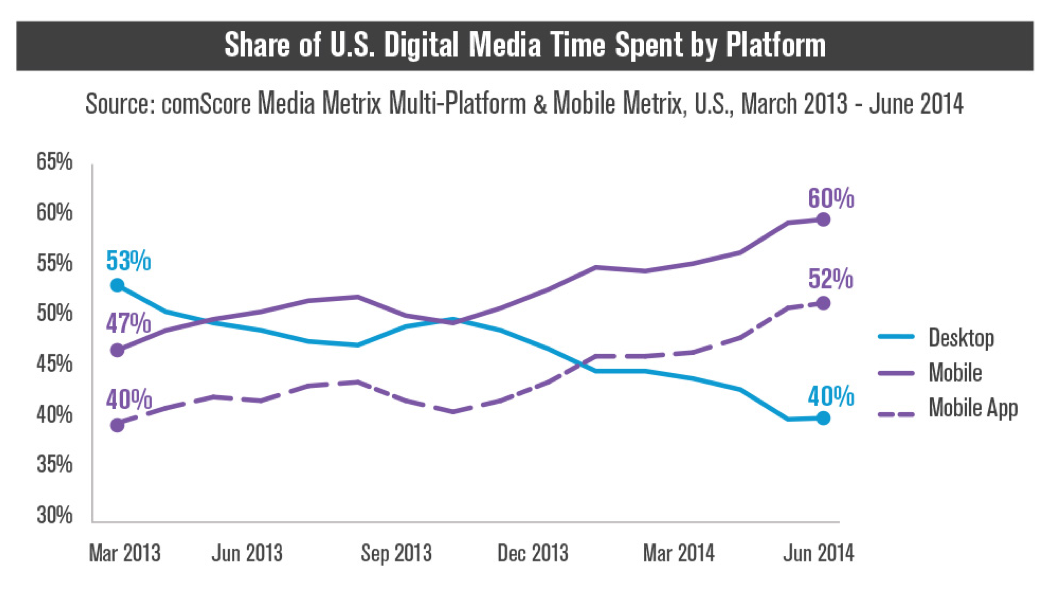
For the past several years, experts have been predicting the domination of mobile Internet use. In 2014, their predictions came true as Internet traffic from mobile devices like smartphones and tablets finally overtook desktop traffic.
 (credit: TechCrunch)
(credit: TechCrunch)
The statistics prove that mobile marketers are in the right place at the right time:
- 80 percent of Internet users own smartphones — in fact, there are now more mobile devices than people worldwide.
- The average smartphone user checks their phone 150 times a day.
- Two-thirds of all email in the US is opened on mobile devices.
It’s clear that mobile should be considered an indispensable component of any marketing activity. But with the rise in mobile usage comes increased competition for your target audience’s attention. The ubiquity of content and apps makes for consumers with short attention spans. Studies show that most website visitors will leave a page within 10 to 20 seconds of arriving. Thus, better publishers, e-commerce merchants, and mobile experience optimization professionals will need to ensure that content is engaging people across all device types.
Fortunately, mobile devices present opportunities to measure data often unavailable with desktop traffic. Users are consuming content not only at their homes and offices, but also during their commute, at the store, and when they’re out with friends, as well as during their leisure hours at home. This additional user data is hugely advantageous for marketing activities that involve targeting. By using that data to segment your audience, you can customize your content for each sub-group, effectively yielding higher engagement and conversion rates.
Segmentation and Behavioral Targeting
The wealth of data provided by mobile users presents amazing opportunities to mobile marketers — if that data is put to use with segmented marketing.
You can quite easily target a specific sector of the audience based on point of access and demographic data. Is the reader accessing your site via desktop or mobile device? How did they arrive there? What’s their geographic location?
The use of website, mobile, and social analytics tools allows you to analyze the big data from your traffic and use it to intelligently group your audience into segments based on their stage in the sales funnel, their location, their browsing habits, their demographics and more.
Real-time e-commerce engagement tools, like Fanplayr, make segmentation and behavioral targeting accessible to businesses of every size. Solutions like this essentially use intelligence collected from big data, in order to provide incentives that a user is most likely to benefit from. With plug-and-play integration into popular e-commerce platforms and even custom carts, the behavioral targeting tool also provides in-depth analytics over users and their browsing and purchase behavior.
When you have this level of deep segmentation, you can customize exactly what your readers are seeing and enable higher conversion rates by tailoring the content to their needs, questions and sales objections. For example, if you know your visitor is from out of state and visiting your website for the first time, you can display tailored content that’s completely different than what you might display to a regular visitor who is local.
Engagement Follows Segmentation
Marketers are familiar with the potential of reaching their audience through social networks, which are prime destinations for internet users seeking engagement with other users and entertainment from news, shared articles, images, and videos. Although the potential to reach a wide audience on social media is obvious, how to get meaningful engagement from that audience is less apparent.
Effective engagement on social networks comes from a deep understanding of your audience’s behavior. You need to understand exactly how your audience is using social media in order to know when and how to most effectively reach out to them. This refers to the type and format of content you should share, as well as the best time and place to share it.
This is best done through cloud-based platforms for analyzing social media activity and maximizing engagement. For example, there are social media management platforms that give you a quick glance into this data and how to effectively engage any target audience. Some possible points of optimization include the best times to share content, what kind, and which networks. With the right tools to analyze your audience and enable large-scale messaging across networks, you’ll be able to maximize your reach and engagement, and ultimately, your conversions.
Be Sticky With Mobile-Friendly Email
Most online content gets just a few seconds of the reader’s time, it’s crucial to create content that’s “sticky” — content that grabs your reader’s attention and doesn’t let go. Email is still one of the best ways to create that kind of lasting connection with your target audience.
With the majority of emails now being read on smartphones and tablets, it’s more important than ever to make sure your email message is delivered in an attractive and readable format regardless of the device on which it ends up being seen.
Mobile marketers need to ensure that messages are either sent in plain-text, or follow guidelines for responsive design, to maximize the chances that they’ll be opened, read and clicked on, regardless of screen size. For instance, there are various incorporated responsive email templates available to ensure email marketers send mails optimized for mobile and tablets.
Seismic Implications
The rise of mobile Internet traffic has been deemed “the biggest shift since the Internet began” by Search Engine Watch, and the trend is sure to continue in the coming years with the rise of wearable tech and the Internet-of-things.
Apple just launched the Apple Watch, making the Internet even more omnipresent in our lives. Wearable tech has the potential to tip the scales even more than smartphones have, since these devices are meant to be worn at all times. The Apple Watch is waterproof, for example, so users can even wear it in the shower! It is also meant to be a replacement for a lot of things, such as wallets (with Apple Pay) and even hotel room keys.
Mobile marketers will need to keep a close eye on these trends in order to stay at the top in this competitive space. As we become more and more dependent on the Internet, the competition for audience attention will only increase. By segmenting and targeting your mobile audience, you can stay in their sights amid all the noise and achieve higher levels of reach and engagement.
Author
Becky is the Senior Content Marketing Manager at TUNE. Before TUNE, she handled content strategy and marketing communications at several tech startups in the Bay Area. Becky received her bachelor's degree in English from Wake Forest University. After a decade in San Francisco and Seattle, she has returned home to Charleston, SC, where you can find her strolling through Hampton Park with her pup and enjoying the simple things in life.


